Leidos Bundle
Can Leidos Continue Its Ascent in a Changing World?
In a world defined by rapid technological advancements and evolving geopolitical dynamics, understanding the Leidos SWOT Analysis is crucial. This analysis delves into the core of Leidos's strategic growth, examining how it navigates the complex interplay of defense, intelligence, civil, and health sectors. From its origins as Science Applications Incorporated to its current status as a Fortune 500 powerhouse, Leidos's journey offers valuable insights into sustainable growth strategies.
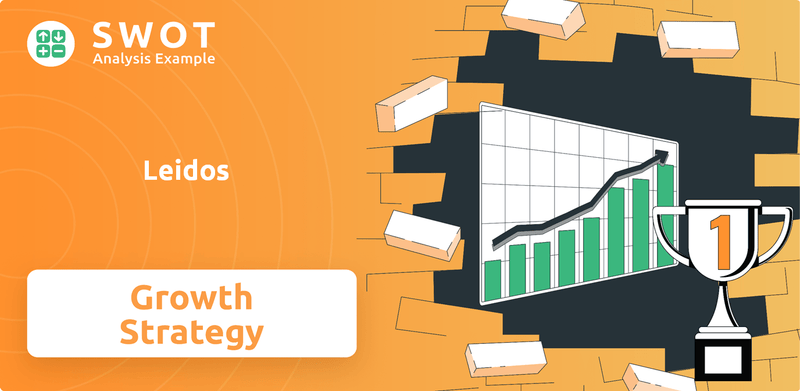
Leidos's impressive Leidos company analysis reveals a robust Leidos business model, fueled by its strategic initiatives and a keen focus on its Leidos market position. With a substantial backlog and consistent Leidos financial performance, the company's future prospects appear promising. Examining its Leidos growth strategy, including its forays into cybersecurity and government contracts, provides a comprehensive view of its potential for continued success.
How Is Leidos Expanding Its Reach?
The expansion initiatives of Leidos are primarily guided by its 'NorthStar 2030' growth strategy, developed in 2024 and fully unveiled in May 2025. This strategy focuses on five key growth pillars: space and maritime, energy infrastructure, digital modernization and cyber, highly customized critical mission software, and managed health services. These areas align with the U.S. government's priorities, ensuring sustained demand for Leidos' services.
Leidos is actively pursuing growth by entering new market segments and strengthening its position in existing ones. This involves strategic acquisitions, securing new contracts, and focusing on technological advancements. The company's approach is designed to capitalize on emerging opportunities and maintain its competitive edge in the market.
The company's expansion efforts are also reflected in its financial performance. For example, the commercial and international business saw a 12% revenue increase in Q4 2024. The defense systems business experienced a 7% revenue climb to $508 million in Q1 2025, driven by increased volumes in hypersonics and space sensing programs. These figures underscore the effectiveness of Leidos' strategic initiatives and its ability to capitalize on market opportunities.
The commercial and international business saw a 12% revenue increase in Q4 2024. This growth was driven by higher deliveries of security products and increased volumes in commercial energy, airborne solutions, and Australian IT businesses. This expansion highlights the company's ability to diversify its revenue streams and expand its global footprint.
In the defense sector, the defense systems business experienced a 7% revenue climb to $508 million in Q1 2025. This increase was primarily due to higher volumes in hypersonics and space sensing programs. This growth showcases the company's strength in providing advanced solutions to meet the evolving needs of the defense industry.
Leidos acquired Kudu Dynamics in May 2025 for approximately $300 million. This acquisition accelerates the company's AI-enabled cyber capabilities for defense, intelligence, and homeland security customers. This strategic move strengthens Leidos' position in the rapidly growing cybersecurity market.
Leidos secured a $276 million task order with the Defense Department Information Analysis Center in August 2024. This contract supports supply chain resiliency through research and development of critical minerals and materials for munitions. This win demonstrates the company's ability to secure significant government contracts.
Leidos' strategic initiatives, including the 'NorthStar 2030' growth strategy, are designed to strengthen its market position and drive sustainable growth. The company's focus on key growth pillars and acquisitions, such as Kudu Dynamics, are critical to its future prospects. These efforts are supported by a strong track record of securing government contracts and delivering innovative solutions.
- The 'NorthStar 2030' strategy emphasizes growth in key areas.
- Acquisitions, like Kudu Dynamics, enhance capabilities.
- Securing government contracts supports revenue growth.
- Focus on technological advancements, such as AI-enabled cyber capabilities.
Leidos SWOT Analysis
- Complete SWOT Breakdown
- Fully Customizable
- Editable in Excel & Word
- Professional Formatting
- Investor-Ready Format
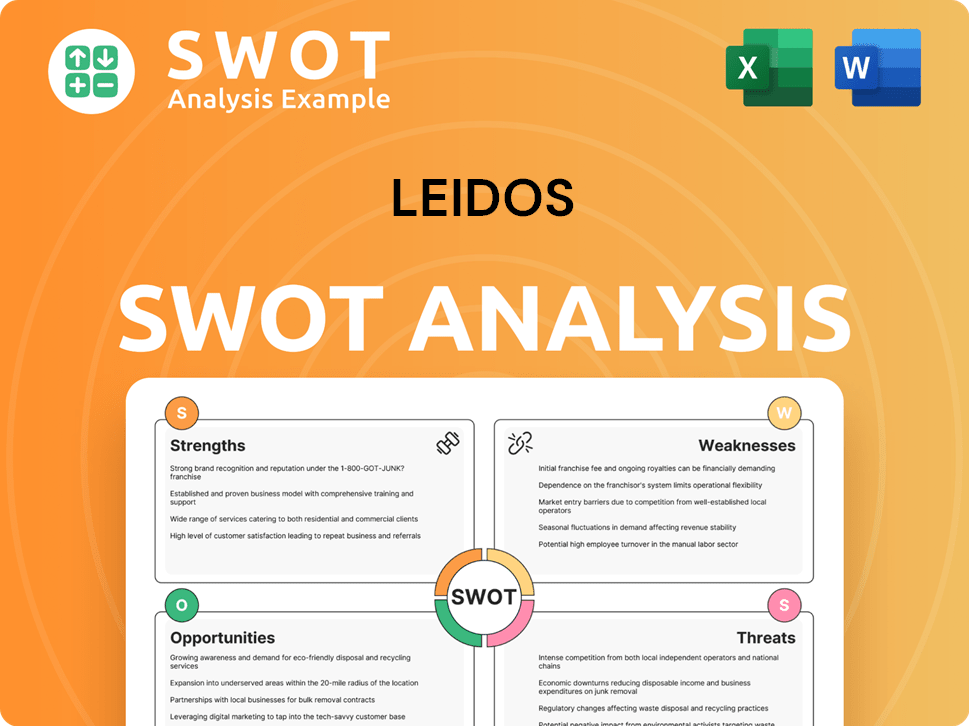
How Does Leidos Invest in Innovation?
The Leidos growth strategy is heavily reliant on technological innovation and strategic investments in research and development (R&D). This approach is critical for maintaining a competitive edge in dynamic markets like digital modernization, cybersecurity, and AI and machine learning. The company's focus on these areas directly addresses the evolving needs of its government and commercial clients, driving its Leidos future prospects.
Leidos company analysis reveals a consistent commitment to advancing its technological capabilities. This commitment is evident in its financial allocations and strategic acquisitions, which are designed to enhance its service offerings and expand its market presence. The company's ability to adapt and innovate positions it well for sustained growth.
In 2024, Leidos invested $98 million in company-funded R&D expenses, underscoring its dedication to technological advancement. This investment fuels the development of cutting-edge solutions in digital modernization, cybersecurity, and AI and machine learning. These initiatives are crucial for supporting its Leidos business model, which centers on providing technology-driven solutions to complex challenges.
Leidos focuses on enhancing digital infrastructure, developing advanced security measures, and integrating AI and machine learning to improve efficiency and decision-making. This approach is a key component of its Leidos strategic initiatives.
The company is increasing its use of Trusted Mission AI as a core element of its architecture. This involves orchestrating solutions across cloud, cyber, customer experience, and application modernization. This is a significant aspect of its Leidos technological advancements.
Automation, including robotic process automation and AI-driven decision-making tools, is used to streamline tasks and reduce errors. This is particularly evident in cybersecurity, enhancing threat detection and response. This supports Leidos growth strategy for cybersecurity.
In May 2025, Leidos acquired Kudu Dynamics to accelerate its AI-enabled offensive cyber, electromagnetic spectrum operations, and vulnerability research strategies. This acquisition strengthens its position in the competitive landscape and supports Leidos acquisitions and mergers.
Leidos develops advanced diagnostic tools and telehealth solutions to enhance patient care and improve healthcare outcomes. This demonstrates its commitment to innovation in the healthcare sector, which is part of its Leidos growth strategy in healthcare.
In 2024, Leidos secured a $218 million contract from DARPA to advance AI and machine learning technologies. This contract highlights the company's ability to secure significant government contracts, which influences its Leidos future prospects for government contracts.
Leidos' focus on innovation extends across several key areas, ensuring its continued relevance and competitiveness in the market. These advancements are critical for maintaining a strong Leidos market position.
- Digital Modernization: Enhancing digital infrastructure for improved efficiency.
- Cybersecurity: Developing advanced security measures to protect against threats.
- AI and Machine Learning: Integrating AI to improve decision-making and automate processes.
- Healthcare Solutions: Creating advanced diagnostic tools and telehealth solutions.
- Trusted Mission AI: Implementing AI across various operational areas.
Leidos PESTLE Analysis
- Covers All 6 PESTLE Categories
- No Research Needed – Save Hours of Work
- Built by Experts, Trusted by Consultants
- Instant Download, Ready to Use
- 100% Editable, Fully Customizable
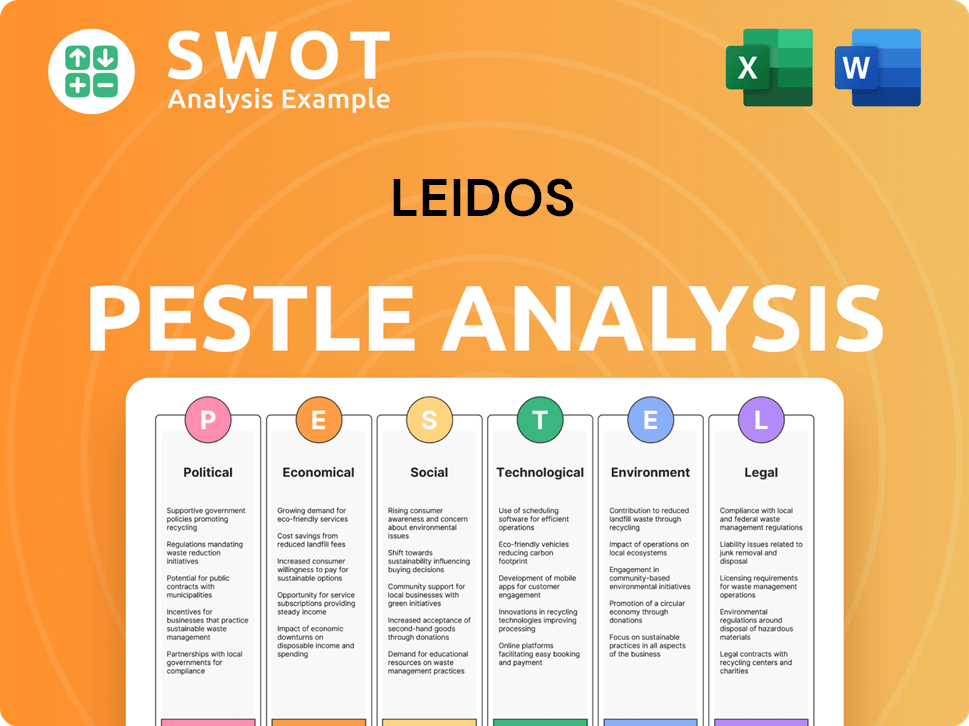
What Is Leidos’s Growth Forecast?
The financial outlook for Leidos is positive, with the company demonstrating strong performance and projecting continued growth. Leidos's financial health is supported by its robust revenue streams and strategic initiatives. An in-depth Target Market of Leidos analysis provides further insights into its market positioning and growth potential.
For Q1 2025, Leidos reported significant gains, exceeding expectations and setting a solid foundation for the fiscal year. The company's strategic focus and operational efficiency are key drivers of its financial success. The company's strong financial performance is a testament to its effective business model and market position.
The company's financial performance is a key indicator of its future prospects. Leidos's ability to secure and execute contracts, coupled with its strategic acquisitions, positions it well for sustained growth. The company's commitment to innovation and customer satisfaction further enhances its market position and competitive advantage.
Leidos's revenue for Q1 2025 reached $4.25 billion, marking a 7% year-over-year increase. This growth reflects the company's ability to secure new contracts and expand existing ones. This strong revenue performance underscores the company's effective growth strategy.
Net income for Q1 2025 was $365 million, a 29% increase year-over-year, with diluted earnings per share of $2.77. Adjusted EBITDA for the quarter was $601 million, a 23% increase from the prior year, with an adjusted EBITDA margin of 14.2%. These metrics demonstrate improved profitability and operational efficiency.
For the full fiscal year 2025, Leidos anticipates revenues between $16.9 billion and $17.3 billion. This projection indicates continued growth, with the potential for up to a 4% increase over 2024's revenue of $16.7 billion. This forecast reflects the company's positive outlook.
The adjusted EBITDA margin is expected to remain in the mid-to-high 12% range. Non-GAAP diluted earnings per share are anticipated to be between $10.35 and $10.75. The company's financial guidance highlights its confidence in its operational performance.
Leidos's strong financial position is reinforced by its substantial backlog and cash reserves. As of April 4, 2025, the total backlog was $46.3 billion, with $7.3 billion funded. At the end of Q1 2025, cash and cash equivalents totaled $0.84 billion, compared to current debt of $0.12 billion. These figures underscore the company's strong financial health and ability to meet its obligations.
The 7% year-over-year revenue increase in Q1 2025 showcases Leidos's ability to expand its business. This growth is driven by new contract wins and the expansion of existing projects. This is a key indicator of the company's successful market strategy.
The significant increase in net income and adjusted EBITDA in Q1 2025 highlights improved profitability. These gains reflect efficient operations and effective cost management. This demonstrates the company's strong financial performance.
The substantial backlog of $46.3 billion, with $7.3 billion funded, provides strong revenue visibility. This backlog ensures a steady stream of future revenue. This supports Leidos's long-term growth prospects.
Leidos's strong cash position, with $0.84 billion in cash and cash equivalents, supports its financial stability. This strong cash position provides flexibility for future investments and strategic initiatives. This demonstrates sound financial management.
The reaffirmed guidance for fiscal year 2025, with revenue projections between $16.9 billion and $17.3 billion, indicates continued growth. This positive outlook is supported by the company's strong backlog and operational efficiency. This highlights the company's positive future prospects.
The expectation to generate approximately $1.45 billion in operating cash flows for 2025 demonstrates the company's ability to generate strong cash flow. This cash flow supports investments and strategic initiatives. This supports the company's sustainable growth strategies.
Leidos Business Model Canvas
- Complete 9-Block Business Model Canvas
- Effortlessly Communicate Your Business Strategy
- Investor-Ready BMC Format
- 100% Editable and Customizable
- Clear and Structured Layout
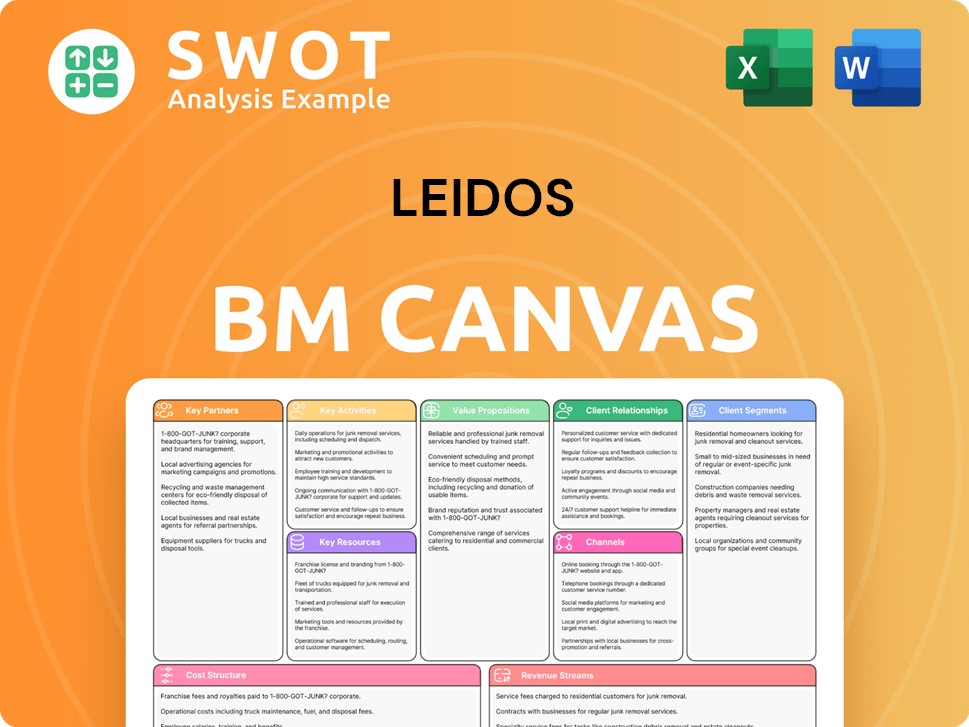
What Risks Could Slow Leidos’s Growth?
The path to growth for Leidos isn't without its challenges. The company faces several potential risks and obstacles that could impact its ability to achieve its strategic goals. Understanding these challenges is crucial for investors and stakeholders assessing the overall Leidos company analysis.
Competition, government procurement issues, and geopolitical instability pose significant threats. These factors can affect Leidos' financial performance and market position. Addressing these risks is essential for ensuring Leidos' long-term success and maintaining its trajectory in the defense and technology sectors.
A critical concern for Leidos is the ongoing labor shortage in the aerospace-defense sector. The high attrition rate, as indicated by the 2024 Aerospace Industries Association (AIA)-PwC Workforce Study, could lead to production delays. This talent gap is a significant hurdle for Leidos' ability to meet its contractual obligations and maintain its competitive edge.
Leidos operates in a competitive market, with rivals like Booz Allen Hamilton and Raytheon Technologies vying for contracts. Intense competition can lead to pricing pressures, affecting Leidos' profitability and market share analysis. This competitive landscape requires constant innovation and strategic initiatives to maintain a strong position.
Government procurement processes can be slow and unpredictable. Delays in contract awards or budget disputes, as experienced in 2023, can disrupt revenue streams and impact Leidos' financial performance. The company must navigate these challenges to ensure a steady flow of contracts and projects.
Geopolitical events can introduce supply chain risks and regulatory uncertainty. While increased defense spending due to global tensions may benefit Leidos, it also brings complexities. Adapting to these changes is vital for Leidos' strategic initiatives and future prospects.
The aerospace-defense industry faces a persistent labor shortage. The AIA-PwC Workforce Study indicates a high attrition rate of 13%. This shortage can lead to production delays and quality issues, affecting Leidos' ability to meet delivery timelines and impacting its overall growth strategy.
Cybersecurity threats require constant investment and innovation. A data leak in July 2024, though unrelated to Leidos' network, highlights the need for robust cybersecurity measures. Maintaining a competitive edge in this area is essential for protecting sensitive data and maintaining customer trust.
Changes in regulations can impact contract negotiations and profitability. Leidos must stay agile and adapt to evolving regulatory environments to maintain its competitive advantage. Compliance and adaptation are key components of Leidos' sustainable growth strategies.
Leidos mitigates these risks through diversification across its segments, a robust risk management framework, and strategic alignment with government priorities. These measures aim to deliver efficiency and cost savings, strengthening its position in the market. Understanding the Marketing Strategy of Leidos can also provide insights into how the company addresses these challenges.
The imposition of U.S. tariffs on major trading partners could raise input costs and introduce supply chain uncertainties. Leidos must carefully manage its supply chains to minimize disruptions. This involves building resilient supply chains and diversifying its sources.
Leidos Porter's Five Forces Analysis
- Covers All 5 Competitive Forces in Detail
- Structured for Consultants, Students, and Founders
- 100% Editable in Microsoft Word & Excel
- Instant Digital Download – Use Immediately
- Compatible with Mac & PC – Fully Unlocked
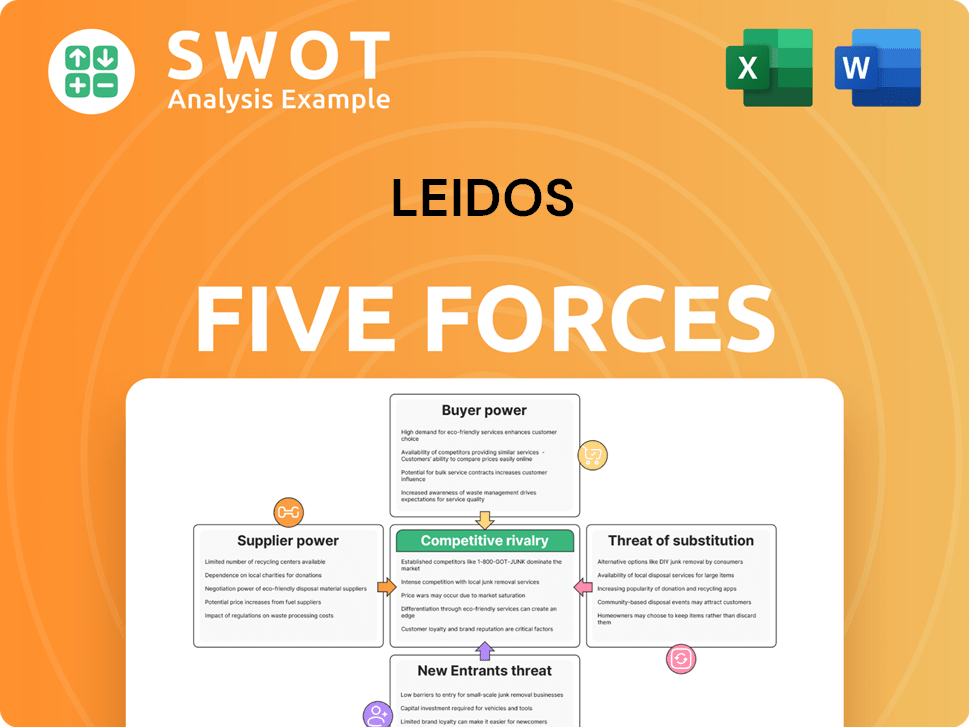
Related Blogs
- What are Mission Vision & Core Values of Leidos Company?
- What is Competitive Landscape of Leidos Company?
- How Does Leidos Company Work?
- What is Sales and Marketing Strategy of Leidos Company?
- What is Brief History of Leidos Company?
- Who Owns Leidos Company?
- What is Customer Demographics and Target Market of Leidos Company?
Disclaimer
All information, articles, and product details provided on this website are for general informational and educational purposes only. We do not claim any ownership over, nor do we intend to infringe upon, any trademarks, copyrights, logos, brand names, or other intellectual property mentioned or depicted on this site. Such intellectual property remains the property of its respective owners, and any references here are made solely for identification or informational purposes, without implying any affiliation, endorsement, or partnership.
We make no representations or warranties, express or implied, regarding the accuracy, completeness, or suitability of any content or products presented. Nothing on this website should be construed as legal, tax, investment, financial, medical, or other professional advice. In addition, no part of this site—including articles or product references—constitutes a solicitation, recommendation, endorsement, advertisement, or offer to buy or sell any securities, franchises, or other financial instruments, particularly in jurisdictions where such activity would be unlawful.
All content is of a general nature and may not address the specific circumstances of any individual or entity. It is not a substitute for professional advice or services. Any actions you take based on the information provided here are strictly at your own risk. You accept full responsibility for any decisions or outcomes arising from your use of this website and agree to release us from any liability in connection with your use of, or reliance upon, the content or products found herein.